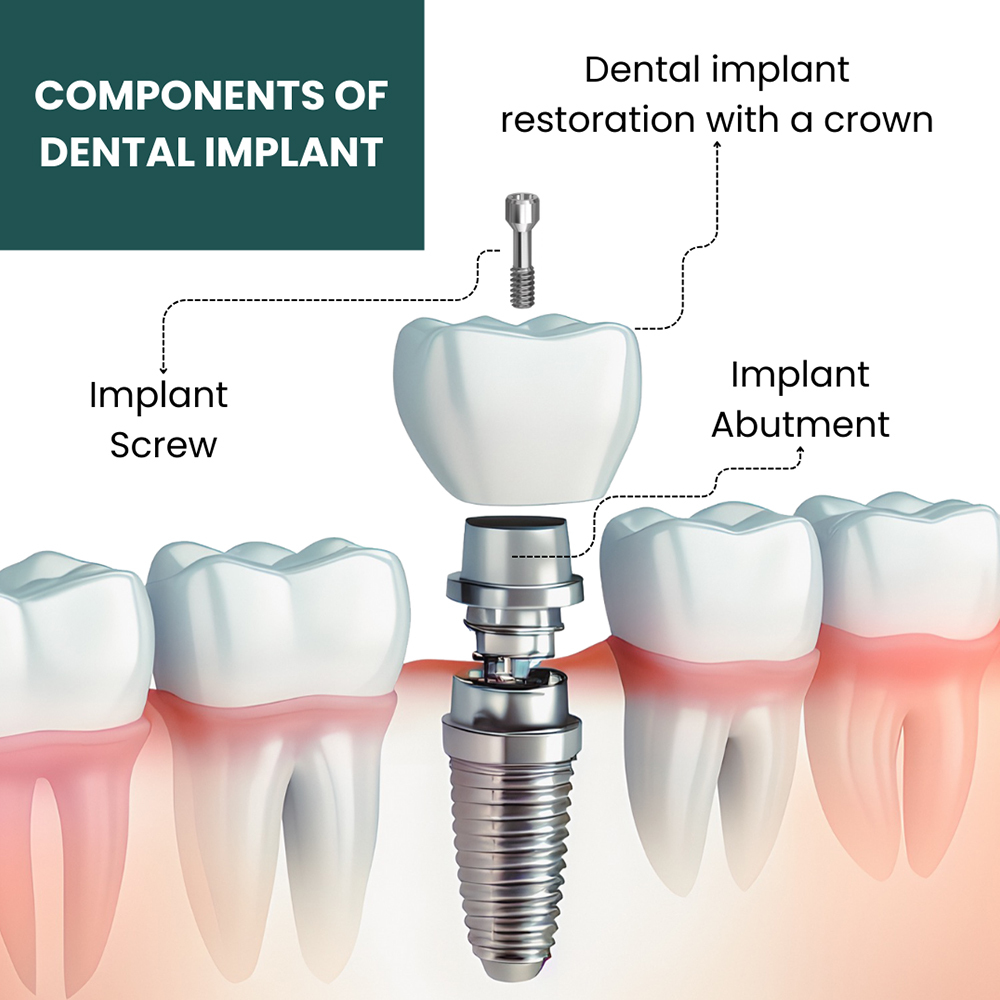Rumored Buzz on Dental Implants
Rumored Buzz on Dental Implants
Blog Article
Indicators on Dental Implants You Should Know
Table of ContentsNot known Details About Dental Implants Dental Implants Things To Know Before You BuyDental Implants for BeginnersSee This Report on Dental Implants
are clinical gadgets operatively dental implanted right into the jaw to restore an individual's capacity to eat or their look. They supply support for synthetic (phony) teeth, such as crowns, bridges, or dentures. When a tooth is shed due to injury or disease, a person can experience difficulties such as rapid bone loss, defective speech, or adjustments to chewing patterns that result in discomfort.
Framework of The Dental Implant System choosing oral implants, talk with your oral company concerning the possible advantages and risks, and whether you are a candidate for the treatment. Points to take into consideration: Your general wellness is a crucial consider determining whether you are a good candidate for oral implants, how much time it will certainly require to heal, and how much time the implant might remain in place.
Cigarette smoking may affect the recovery procedure and lower the lasting success of the implant. The healing process for the dental implant body may take numerous months or longer, during which time you typically have a short-lived joint in location of the tooth. the oral implant treatment: Carefully adhere to the oral hygiene instructions offered to you by your oral company.
Top Guidelines Of Dental Implants
Implant failure can result in the need for an additional surgery to take care of or change the dental implant system. Brings back the ability to eat Brings back aesthetic look Helps keep the jawbone from reducing as a result of bone loss Protects the health and wellness of the bordering bone and gum tissues Helps maintain surrounding (nearby) teeth stable Boosts high quality of life Damages to bordering all-natural teeth during dental implant positioning Injury to the surrounding tissues throughout surgery, such as sinus perforation Injury during surgical treatment (for instance, crack of surrounding jawbone) Insufficient feature, such as seeming like the teeth do not bite with each other generally An experience that the tooth hangs or twisting in position resulting from an abutment screw loosening up Implant body failure (looseness of the dental implant body) due to systemic infection, which might be most likely in clients with uncontrolled diabetes due to regional infection in bone and gums supporting the dental implant body as a result of delayed healing, which might be much more most likely in clients who smoke Trouble cleansing the gums around the implant, resulting in poor dental hygiene Untreated periodontal condition Post-surgical pins and needles because of nerve impingement or damages Always notify wellness care carriers and imaging service technicians that you have oral implants before any kind of magnetic resonance imaging (MRI) or x-ray procedures.
FDA is not familiar with any type of damaging occasions reported for MRI or x-ray procedures with oral implants. Dental implants systems are typically made from products that adhere to international agreement criteria of the International Organization for Standardization (ISO) or ASTM International. These criteria have information of what makes a risk-free material.
Oral dental implant systems are reviewed according to global agreement criteria. Biocompatibility screening, to show that bodily contact with the gadget does not trigger issues like irritation or sensitive response, is component of the examination that assists make sure the products in the oral implant system are safe and do not create adverse results when dental implanted in individuals.

Dental Implants Fundamentals Explained
Some individuals are not qualified for dental implant surgery. It is for oral important site doctors to operate on people with: intense illnessuncontrollable metabolic diseasebone or soft tissue disease or infectionIf these concerns are dealt with, a person can have the surgery. Dental Implants. In, oral specialists avoid from operating people with: If individuals with any of the above undergo dental implant surgical treatment, there is a greater threat of the implant falling short
Some individuals have a jawbone irregularity that stops enough bone for a dental implant from developing. In such situations, a surgeon may need to perform a ridge adjustment. This entails lifting the gum to expose the area of warped bone. The specialist will then make use of a bone or bone substitute to fix and develop the area.
Dental implant surgery is a customized process. It's not the very same for everybody. Yet the adhering to offers a basic review of what you can expect your dentist, oral surgeon, periodontist or prosthodontist to do: Put the implant operatively. Offer you time to recover. Affix the article and last crown, bridge or denture.
Next, your surgeon will very carefully position the oral implant into your jaw. Your surgeon will rearrange your gums and shut the cut with stitches (Dental Implants). If your implant is near the front of your mouth, your dentist will certainly make a short-term tooth for you to wear up until you heal. This way, you won't have a space check it out in your smile while you recuperate.
The 3-Minute Rule for Dental Implants
Your service provider can inform you what to anticipate in your situation. During the healing phase, your jawbone ought to fuse to the dental implant. This procedure, called osseointegration, is crucial for stability and long-term success. This procedure can take anywhere from three to 9 months. Sometimes, it may take longer.
As soon as your dental implant heals, your my response dental professional can attach the joint (tiny port post) and your final reconstruction (crown, bridge or denture). This normally takes regarding one hour to finish and might need a 2nd small surgery. You shouldn't feel any kind of pain during your dental implant treatment since your service provider will certainly make use of drug to numb your gum tissues.
Report this page